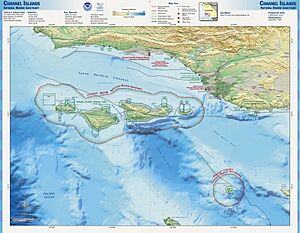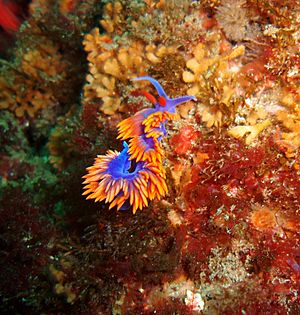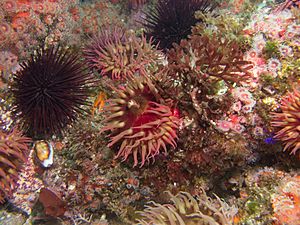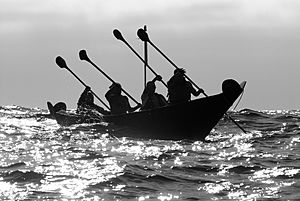Channel Islands National Marine Sanctuary facts for kids
Quick facts for kids Channel Islands National Marine Sanctuary |
|
|---|---|
|
IUCN Category V (Protected Landscape/Seascape)
|
|
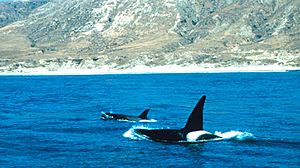
|
|
| Lua error in Module:Location_map at line 420: attempt to index field 'wikibase' (a nil value). | |
| Area | 1,470 sq mi (3,800 km2) |
| Established | 1980 |
| Governing body | National Oceanic and Atmospheric Administration |
The Channel Islands National Marine Sanctuary is a special underwater park off the coast of Southern California. It's a protected area managed by the National Oceanic and Atmospheric Administration (NOAA).
This sanctuary was created on May 5, 1980. It covers about 1,470 square miles (3,800 square kilometers) of ocean. This includes the waters around five of the eight California Channel Islands: Anacapa, Santa Cruz, Santa Rosa, San Miguel, and Santa Barbara Islands. The sanctuary helps protect amazing ocean life, like whales. It also protects over 150 old shipwrecks. This area is very important to the Chumash people, who have lived here for thousands of years. The sanctuary works to protect these natural and cultural treasures through learning, saving, science, and caring for the ocean.
Contents
Fun Things to Do
There are many fun things you can do at the sanctuary! You can go scuba diving, snorkeling, kayaking, or boating. Many people enjoy guided trips and sailing. It's a great place to watch whales and other ocean animals. Fishing is also allowed in some areas. The sanctuary is home to many different kinds of marine mammals. Its calm waters are perfect for boaters and kayakers all year round.
To help protect the ocean while people still have fun, special areas called Marine Protected Areas (MPAs) were set up. These areas are like underwater parks where certain activities are limited. There are 11 marine reserves where you cannot take or harvest anything. This means no fishing or collecting. There are also two marine conservation areas where you can catch some lobster and certain fish. This network of protected areas covers about 318 square miles (824 square kilometers).
More than 150 historic ships and aircraft have been lost in the sanctuary's waters. So far, only about 25 have been found. Scuba divers can explore some of these protected wrecks. But remember, it is against the rules to remove any items from them. The Santa Barbara Maritime Museum is a good place to learn about shipwrecks and the area's ocean history.
If you visit the sanctuary, you can also go ashore on the islands. At Channel Islands National Park, you can go camping, hiking, and do other outdoor activities.
Learning About the Ocean

The Channel Islands National Marine Sanctuary loves to teach people about the ocean. They have many programs to help everyone understand and protect marine life.
MERITO Program
The MERITO program is a special education program that works with the sanctuary. MERITO means 'merit' in Spanish. It helps teach students, teachers, and families about ocean conservation. They offer bilingual (two-language) programs, internships, and even an academy.
Visitor Centers and Partners
The sanctuary has visitor centers and exhibits. These places show how important the sanctuary and its protected resources are. There's also a group called the Channel Islands Naturalist Corps. These are trained volunteers who teach people on whale watching boats about the sanctuary and the National Park.
Learning About Protected Areas
Sanctuary staff work with a team to share information about the Marine Protected Areas (MPAs). They create workshops for teachers and students, learning materials, signs, and videos. These tools help everyone understand why these protected areas are important.
Helpful Information
The sanctuary gives out brochures and pamphlets. These cover topics like boat safety, scuba diving safety, and how to watch whales responsibly. Their website also has lots of information. You can find a list of shipwrecks, an encyclopedia of animals in the sanctuary, and a database of whale sightings.
Resources for Students and Teachers
- Long-term Monitoring Program: This program lets students, teachers, and volunteers collect data about rocky shores and sandy beaches in California.
- MERITO Academy: This program helps teachers of 5th to 8th graders learn about ocean topics. It includes lesson plans, classroom visits, and field trips.
- NOAA B-WET Program: This program gives money to support environmental education. It helps students, teachers, and communities learn about watersheds.
- NOAA Teacher at Sea: This program lets teachers go on research ships. They learn about the ocean and maritime work. This helps them teach their students better.
Ocean Research
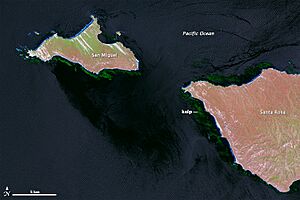
The Channel Islands National Marine Sanctuary is known for its amazing variety of ocean life. Scientists here work with other groups, like universities and government agencies, to study the ocean. They use special research vessels like the Shearwater and Shark Cat to help them.
Here are some things they are currently studying:
Checking Protected Areas
The sanctuary has 13 marine reserves and conservation areas. Scientists study these areas to see if they are helping the ocean ecosystem. They want to know if protecting these areas helps fish and other animals grow and then "spill over" into areas outside the reserves. They also study how different animals in the food web interact with each other.
Climate Changes
Scientists are looking at how short-term climate changes affect the ocean. They study how changes in wind strength can impact the ocean. Stronger winds can affect upwelling, which brings cold, nutrient-rich water to the surface. This also matters for people who want to go boating or fishing. If climate change causes more windy days, there will be fewer good days for these activities.
Watching from the Air
The Sanctuary Aerial Monitoring and Spatial Analysis Program (SAMSAP) uses planes to watch the sanctuary. They collect information on how many boats and visitors are in the area. They also count whale populations. This program has been running since 1997 and helps with managing the sanctuary and responding to emergencies.
Whale Studies
Many large whales were hunted in the past, but now some populations are growing again. The Channel Islands National Marine Sanctuary is a seasonal home for several types of large whales. From spring to fall, you can see humpback, blue, and fin whales. Gray whales also swim through the sanctuary on their long journeys. Sometimes, many whales gather in one spot. Scientists want to know why they gather there. They study what the whales eat, like tiny shrimp called krill. This helps them predict where whales might be. This information can help reduce collisions between whales and large ships. Scientists also tag whales to learn about their movements and how they react to ships.
Ship Traffic
The Port of Los Angeles and Long Beach is a very busy harbor. Many large ships pass through the Santa Barbara Channel and the sanctuary on their way to other ports. These ships are big and fast. They also create a lot of noise underwater and release exhaust. Scientists monitor the noise levels in the sanctuary to see how ships affect the environment. They use special data to track ship movements and understand their impact.
Deep Ocean Life
Most of the sanctuary is very deep, over 100 feet (30 meters) deep. Some parts are even deeper than 5,000 feet (1,500 meters)! In these deep, cold, and dark waters, many unique animals live. These include corals, sponges, crabs, shrimp, fish, and worms. In 2010, NOAA explored an underwater area to learn more about deep-sea corals and sponges.
Underwater History
The Channel Islands National Marine Sanctuary is in charge of protecting old things found on the ocean floor. This includes shipwrecks and ancient land sites that are now underwater. The sanctuary works to find these sites, study them, teach people about them, and make sure visitors use them responsibly.
The Chumash People
The northern Channel Islands have been home to the Chumash people for thousands of years. The oldest human remains found here are over 13,000 years old. Today, the Chumash community still celebrates their ocean heritage. They have an annual event where they cross the Santa Barbara Channel in traditional plank canoes called tomols.
Protected Animals

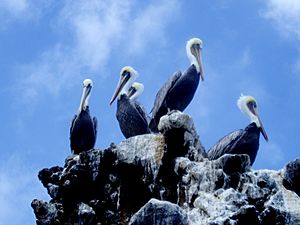
Many animals in the Channel Islands National Marine Sanctuary are protected. This means they are either endangered, threatened, or a species of concern.
Endangered Animals
These animals are in danger of disappearing forever:
- White abalone
- Tidewater goby
- Blue whale
- Humpback whale
- Fin whale
- Sei whale
- Sperm whale
- California least tern
- Black abalone
- Leatherback sea turtle
- Green sea turtle
Threatened Animals
These animals are likely to become endangered soon:
- Scripps's murrelet
- Guadalupe murrelet
- Southern sea otter
- Canary rockfish
- Snowy plover
- Island Fox
Animals of Concern
These animals need special attention to make sure their populations stay healthy:
- Copper rockfish
- Brown rockfish
- Pink abalone
- Bocaccio rockfish
- Ashy storm petrel
Animals No Longer on the List
These animals were once in trouble but are now doing better:
Sanctuary Advisory Council
The Sanctuary Advisory Council was created in 1998. It helps make sure that the public has a say in how the sanctuary is managed. This group gives important advice and ideas to help protect the sanctuary. It includes 21 members from local groups and government agencies.
Dangers to the Sanctuary
Protecting the Channel Islands National Marine Sanctuary is a team effort. Many local, state, and federal groups work together. The sanctuary focuses on teaching people, setting rules, and preparing for emergencies. They also work with the Advisory Council to get advice.
Current dangers to the sanctuary include:
- Ships hitting endangered whales.
- Ocean acidification, which makes the ocean more acidic.
- Invasive species, which are plants or animals that don't belong there.
- Damage to eelgrass beds, which are important habitats.
- Marine debris, like trash in the ocean.
- Poaching, which is illegal hunting or fishing.
- Water pollution.


